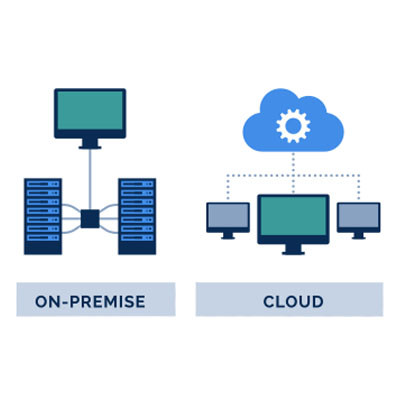IC Data Communications LLC Blog
With cloud storage so affordable and accessible, you have to ask yourself if it’s worth investing in it compared to larger-capacity hard disk drives. Which one is more ideal for your company’s needs? You have options, after all, and it’s important to consider them all before committing to a solution. Let’s examine the pros and cons of each, specifically focusing on the business model for both.
A digital transformation can revolutionize the way a business operates. One of the technologies that make up for an across-the-board transformation is the use of digital storage in lieu of physical paper-based storage of data. Let’s go through a couple of considerations that go into going paperless, and how it can be a benefit for your organization.
Your business has to promote security whenever it can. In terms of keeping your wireless connections secure, the thought behind it is that if unauthorized people and machines can access your network without protections, they can do what they please with the data on the network. This is a big problem. Let’s go through a few things you need to consider to keep your wireless network secure.
If you are like many businesses, you use a lot of services from other companies to try and get all the business computing you need, without having to buy new servers and pay company IT administrators to look after them. This process is understandable, but are you really saving money by doing it? This month we will take a look at the myriad of services that businesses use and if it is, as advertised, saving them money.
Technology can be pretty expensive to buy and maintain, but it can get a whole lot more expensive if you aren’t cognizant of how your IT dollars are being spent. Long ago are the days when companies could get their technology for a song and it would work for years at a time. Today’s business technology has to build a more efficient workplace, as capital is harder to come by today than it has been for quite some time. Let’s take a look at four ways you could be wasting your technology budget and what you can do to ward against it.
Data storage is one of those things in business that only is an issue if you don’t have enough of it. It used to be a considerable challenge for businesses, but today data storage prices are dropping by 20-to-30 percent annually and it has made it feasible for any business to start using cloud computing to store business data. This month we will take a look at the benefits of cloud storage and how there is only one major problem with it.
Business is filled with all types of relationships, and some of them are very challenging. Consider for a minute how challenging some of the interactions you have with customers are; or some of the vendor conversations that happen; or some of the give-and-take you get from your employees. Sometimes it is hard to believe that without these people, your business would be a complete flop. This month, we break down how sometimes the relationships you forge in business are the key to things breaking your business’ way.
Having data redundancy is something that sounds like a bad thing. After all, redundancy is typically viewed as a reason for inefficiency. In the case of having your data and computing environments backed up, you are trying to build redundancy. Today, let’s take a look at some situations that a business can run into should they neglect to have a proper backup.
A business’ operations are heavily influenced by the quality of its communications. However, the overwhelming number of options that are available today can make it challenging to decide how to invest in your technologies. Let’s talk about how you can identify which of your options are right for your business needs, and when the time comes to upgrade your communications.
It’s undeniable that the smartphone is one of the best inventions of the 21st century. You can tell that by their adoption rates. These devices have completely changed the way people communicate, recreate, and work. They are so new that it’s funny to think that maybe in the very near future, these devices will be nothing more than trash in the world’s landfills. Today, we will briefly discuss what comes after the smartphone.
Every business’ clients trust that they’re taking every measure possible to protect data, like personal information or financial records. However, with the number of businesses using electronic records continuing to climb, along with the rise of cybercrime, many industries have begun to impose regulations and compliances that are designed to keep personal information secure. Health and finance are two of the most heavily regulated industries, with the government having stepped in and set a specific standard of data security regulations that these companies must comply with.
With so many threats in business, it doesn’t take much to fall victim to a cyberattack or a scam. Understanding the dangers out there is the first step in enacting a cybersecurity process that can keep your users and your business safe. Let’s take a look at how to build one in this month’s newsletter.
Cloud computing has been touted as one of the most innovative and important technologies for smaller businesses as they look to compete with larger organizations. How it makes this possible is by offering dynamic computing environments that can help bring these smaller businesses into the information age without saddling them with massive infrastructure costs while doing so. That’s not to say that the cloud is cheap by any means, and this month we will discuss how cloud computing is a great option for nearly any business.
Ransomware is one of the worst situations that any business could have to deal with. It not only holds your data or computing infrastructure for ransom, it also creates situations where you have to explain to your clientele that you’ve been breached and that their information has fallen into the hands of scammers looking to extort your business. This month, we thought we would take you through a ransomware attack to give you an idea of just how unpleasant it is.
Chances are that when you signed up for Internet service through your Internet service provider, or ISP, they hooked you up with a router that you would use to broadcast your wireless network’s signal around your office. While this is all well and good, we think you have valid reasons to replace that router with one that is better suited to your business’ needs. Why, you ask? Read on and find out.
We’re no strangers to talking about artificial intelligence. It’s been a somewhat regular topic on our blog and in our newsletters. AI is interesting—it’s sort of this odd technology that for many years, the average person didn’t know what to do with it. Now, it feels like AI is the dominating new technology of the year. What happened? Will it stick? Can a business take advantage of it?
Are you the kind of person that frequently checks your phone to remove the myriad of notifications that come in from seemingly every app on your phone? In the course of doing that frequent clean up you may have cleared a notification that you may need. This month we will tell you how to turn on your Android device’s notification history feature.
So much goes into proper network security that it can be daunting to know where to start. Thankfully, there are plenty of great ways you can, and probably currently are, protecting your business, even if it’s on a basic level. You can consider this a checklist of crucial network security tools that are important to have for your company’s success.




















